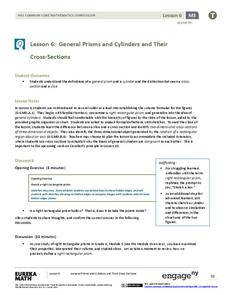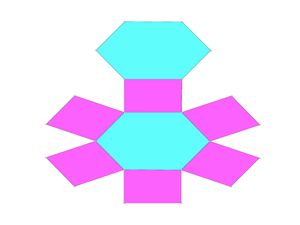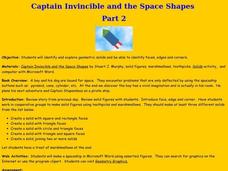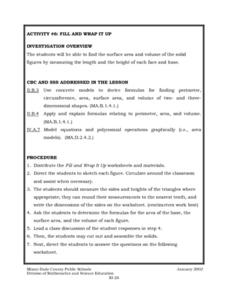EngageNY
General Prisms and Cylinders and Their Cross-Sections
So a cylinder does not have to look like a can? By expanding upon the precise definition of a rectangular prism, the instructional activity develops the definition of a general cylinder. Scholars continue on to develop a...
Radford University
Fun with Solids
Unlike a volcano, the lesson won't blow up in your face. Young mathematicians use dried beans to discover the relationship between the volumes of cones and cylinders and to write a formula for the volume of a cone. They then research...
Curated OER
Solids in the Playground
First graders locate and identify solids in the schoolyard. For this geometric solids lesson, 1st graders locate two solids on the playground. They work as a group to compare and contrast them according to shape, texture, weight, size,...
Curated OER
Make the Shape into a Solid
In this geometry worksheet, students rewrite word problems using symbols and formulas. They calculate the volume of the different solids. There are 8 questions.
Math Worksheets 4 Kids
Sorting 2-D and 3-D Shapes
Challenge mathematicians to examine and sort a variety of 2-D and 3-D figures with a 10-problem solid shapes worksheet.
EngageNY
Examples of Functions from Geometry
Connect functions to geometry. In the ninth installment of a 12-part module, young mathematicians create functions by investigating situations in geometry. They look at both area and volume of figures to complete a well-rounded lesson plan.
Curated OER
Solid Figures
Students investigate solids. In this geometry lesson plan, students use toothpicks and gum drops to solve problems. They create visuals to help them see what is happening to the shapes.
Curated OER
Faces, Edges, and Vertices
In this solid figures worksheet, students learn to identify solid figures by their faces, edges, and vertices. Students solve six word problems about the solid figure characteristics.
Curated OER
Attributes of Solid Shapes- First Grade Reteaching Worksheet
In this attribute of solid shapes reteaching worksheet, 1st graders review the meaning of faces, corners, curves, and edges. They complete 8 examples by circling the curves, faces, edges, and corners on the given shapes.
Curated OER
Captain Invincible and the Space Shapes
Students recognize the features of geometric shapes. In this geometric shapes lesson, students listen to Captain Invincible and the Space Shapes. Students create solid figures with marshmallows and toothpicks. Students create...
Mathematics Vision Project
Module 5: Modeling with Geometry
Solids come in many shapes and sizes. Using geometry, scholars create two-dimensional cross-sections of various three-dimensional objects. They develop the lesson further by finding the volume of solids. The module then shifts...
Mathematics Vision Project
Module 7: Modeling with Geometry
Model good modeling practices. Young mathematicians first learn about cross sections and solids of revolution. They then turn their attention to special right triangles and to the Laws of Sine and Cosine.
Curated OER
Living in a Geometrical World
Students participate in a series of hand-on, online, and multimedia activities to examine 2 dimensional and 3 dimensional shapes. They describe common geometric solids. They construct rectangular prisms using straws and ribbon.
World Wildlife Fund
Arctic Shapes
In a two-part worksheet, young geometers examine 3-D shapes and describe their attributes in a table. They will be able to draw the shape and name the number of vertices, faces, and edges. In the second part, individuals explore...
Curated OER
Sorting 3-Dimensional Shapes
Three-dimensional shapes can be categorized based on their attributes, and scholars learn more about six figures through this sorting activity. They examine six shapes: sphere, cylinder, cone, cube, prism, and pyramid....
SEN Teacher
Nets (3D Models)
Let your learners pick and create a fun shape from this custom template. Shapes range from complex geometric figures to the more common cube and prism. Each page can be labeled with your personal directions. Additional printable listed...
Annenberg Foundation
Geometry 3D Shapes: Euler's Theorem
How do you get a theorem named after you? Euler knows what it takes! The third lesson of five asks pupils to use an interactive activity to compare the faces, vertices, and edges of seven different three-dimensional solids. They use...
Curated OER
Find the surface area of solids
In this online math worksheet, learners find the surface area of a variety of solid figures given their dimensions. This excellent resource allows the students to check their answers, and to get "hints" should they run into difficulties....
Curated OER
Match Game: Enrichment
In this solid figures worksheet, students choose a shape from the box that fits the bar graph totals for the faces, edges, and vertices. Students then complete the last bar graph using the one unused shape.
Curated OER
Finding Volume
Sixth graders develop a rule for finding the volume of rectangular solids using colored cubes. They investigate the properties of solid figures and find the volume of an object by counting units. Students fill spaces with standard-sized...
Curated OER
Fill and Wrap It Up
Middle schoolers find the surface area and volume of the solid figures by measuring the length and the height of each face and base. They use concrete models to derive formulas for finding perimeter, circumference, area, surface area,...
Curated OER
3-D Figures Part 1
Elementary schoolers explore 3-D shapes. They transition from thinking of shapes as only 2-D. Pupils read Cinderella as a launching activity for their upcoming adventure, and explore a new world of 3-D shapes in this introductory lesson.
Curated OER
Doctor, Doctor, Give Me the News, I've Got a Bad Case of Loving Math
Solve a real-world problem of discovering how many doctors and nurses can be hired within budget and building constraints. Using different colored pencils to shade each graph, they then find the intersection points and use these to solve...
Curated OER
Marshmallow Geometry
In this three-dimensional shapes geometry lesson, learners identify geometric solids and name their properties. They define "face," "edge," and "vertex," and construct geometric solids using marshmallows as vertices and toothpicks as edges.

























